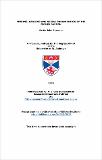Files in this item
Feeding, ranging and social organisation of the Guinea baboon
Item metadata
| dc.contributor.advisor | Whiten, Andrew | |
| dc.contributor.author | Sharman, Martin John | |
| dc.coverage.spatial | 287 | en_US |
| dc.date.accessioned | 2012-06-21T13:02:30Z | |
| dc.date.available | 2012-06-21T13:02:30Z | |
| dc.date.issued | 1982 | |
| dc.identifier.uri | https://hdl.handle.net/10023/2833 | |
| dc.description.abstract | Before this study, the Guinea or Western baboon, Papio papio, was almost unknown in its natural environment. This thesis reports a nineteen-month field study of two troops of P. papio carried out in south-eastern Senegal. The monkeys were followed on foot, and aspects of their feeding, ranging and social behaviour were recorded. The troops were censused whenever possible. Both study groups, and other troops in the area, were found to be unusually large by comparison with other known troops in the genus, and although their age-sex compositions were not exceptional, there was some indication that recruitment into the adult population was low. The activity budgets of both troops were similar, and members of both troops spent more time moving and feeding in the dry season than they did in the wet, when they spent more time in social behaviour. These differences were probably related to seasonal changes in productivity, which were large, since no rain feel in six months of the year. The home range of one of the study troops covered about 45 to 50 square kilometres, while the other troop, whose home range was less well known, ranged over about 18 to 20 square kilometres. There were no seasonal differences in the mean distance travelled per day by either troop, although there was great daily variation about the mean of roughly 8 kilometres. This distance was greater than that travelled by most other troops of baboons, and was ascribed to low productivity in the dry season and large troops in the wet. The troops visited some habitats more frequently than they did others, and moved more slowly through those that they visited frequently than through those that they visited frequently than through those they visited less frequently. In the dry season both troops visited areas in which there was relatively dense shade more frequently than they did areas with little shade. In the wet season they avoided areas in which variability was poor. Sleeping sites were found to have a profound influence on the ranging patterns of the baboons, with usage of the home ranges being inversely proportional to the square of the distance from the nearest sleeping site. The baboons apparently chose to sleep in trees which afforded them protection against predation. The sleeping sites were restricted to places in which there was permanent water. The baboons were largely frugivorous. In this they resembled baboon troops studied in other areas. Their diet changed throughout the year, as various plants fruited or seeded, and was more diverse in the wet season, when a wider variety of foods was available. More than a hundred different food items were known to be eaten, and the number of known food types increased throughout the study. Animals in their diet were mostly invertebrates found beneath boulders, but some vertebrates were also eaten. The social organisation and mating system of these baboons were compared with those of the other baboons, including Theropithecus gelada. It was unlikely that they lived in a society in which adult females were constrained to mate with only one male, as are females in two other species of baboon. Instead, there appeared to be competition for sexual partners, with the formation of consortships between adults during the time of the female’s oestrus. Adult males groomed each other in this species, which is uncommon in baboons with competitive mating, except at times of stress. | en_US |
| dc.language.iso | en | en_US |
| dc.publisher | University of St Andrews | |
| dc.subject.lcc | QL737.P93S2 | |
| dc.subject.lcsh | Baboons | en_US |
| dc.subject.lcsh | Baboons--Behavior | en_US |
| dc.title | Feeding, ranging and social organisation of the Guinea baboon | en_US |
| dc.type | Thesis | en_US |
| dc.type.qualificationlevel | Doctoral | en_US |
| dc.type.qualificationname | PhD Doctor of Philosophy | en_US |
| dc.publisher.institution | The University of St Andrews | en_US |
This item appears in the following Collection(s)
Items in the St Andrews Research Repository are protected by copyright, with all rights reserved, unless otherwise indicated.

